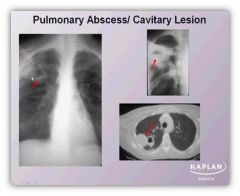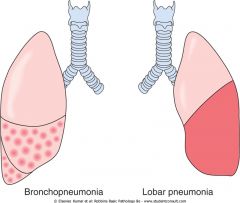![]()
![]()
![]()
Use LEFT and RIGHT arrow keys to navigate between flashcards;
Use UP and DOWN arrow keys to flip the card;
H to show hint;
A reads text to speech;
38 Cards in this Set
- Front
- Back
|
Describe the classical presentation of pneumonia.
|
• Sudden onset of fever
• Chills (the new hypothalamic set-point for temperature makes the patient feel cold until the new set-point is reached) • Cough with or without purulent sputum • Pleuritic chest pain • Dyspnea |
|
|
What organisms are the usual culprits of pneumonia?
|
Usually S. pneumoniae (in both immunocompetent and immunocompromised individuals)
H. influenzae, M. catarrhalis, S. aureus or gram-negative enteric bacteria may be the culprits. |
|
|
What tests could be done in a patient with pneumonia and productive cough?
|
Gram-stain of sputum. The specimen must be adequate, meaning that it has to contain greater than 25 neutrophils and less than 10 squamous cells.
|
|
|
This organism is the most likely cause of bacterial pneumonia complicated by ABSCESS FORMATION.
|

S. aureus. It is the most destructive to lung tissue and most likely to cause cavitary lesions.
|
|
|
Normal lungs are ________ below the first major bronchial divisions.
|
sterile
|
|
|
__________ and ________ are examples of bacteria that are deposited directly in the lower airways through inhalation of small airborne particles (tiny bacteria).
|
M. tuberculosis; L. pneumophila
|
|
|
The chest x-ray in classic pneumonia shows a ________ confined to a particular lobe of the lung that correlates with location of __________.
|
focal consolidation; pleuritic chest pain (pleurisy)
|
|
|
Consolidation refers to?
|
There is alveolar infiltrates in a region of the lung, making it more *solid* to the touch. It consists of pathogens and the inflammatory exudate which is cell rich, containing inflammatory cells and proteins.
|
|
|
List all the pulmonary defense mechanisms.
|
• Starts in the nose; there is abrupt change in the direction of airflow in the nose, which potentially traps pathogens.
• Cough reflex. • Ciliated respiratory epithelium. • Humoral factors (Lysosyme, IgA in mucus or potentially IgG + C from the blood). • Alveolar macrophages (and potentially neutrophils via diapedesis). • Most extensive lymphatics in the entire body (lungs) |
|
|
Atypical pneumonia results from a more ________ process and include more prominent __________ symptoms with less ________ complaints.
|
indolent; constitutional; pulmonary
Constitutional symptoms: Low-grade fever, myalgias, fatigue, arthralgias, headache, sore throat, skin rash. |
|
|
The cough in atypical pneumonia is typically _________.
|
non-productive
|
|
|
Atypical pneumonia is most commonly caused by __________.
|
Mycoplasma pneumoniae (remember, no cell wall on this one)
|
|
|
What organisms can cause atypical pneumonia other than the most common type?
|
• C. pneumoniae
• Legionella (infected water like shower or the fine spray of water covering vegetables in a grocery store) • M. tuberculosis • Viruses such as Adenovirus, Parainfluenza, RSV • Fungus such as Aspergillus, Coccidiomycosis, Histoplasmosis, Pneumocystic jirovecii |
|
|
The gram-stain procedure in atypical pneumonia is ________.
|
less diagnostic.... it contains fewer neutrophils.
|
|
|
The chest X-ray in atypical pneumonia ______, but will often show ___________.
|
varies; bilateral patchy/interstitial infiltrates
|
|
|
Animal exposure can cause pneumonia. Which organisms can be involved?
|
• C. psitacci (birds)
• C. burnetii (animals) • Hanta virus (rodents) These three cause acute symptoms. • C. neoformans (birds, like PIGEONS) Causes more subacute and chronic symptoms. |
|
|
H. capsulatum is endemic in _______.
|
Endemic in Mississippi & Ohio river valleys.
|
|
|
What are some general risk factors for pneumonia?
|
• Elderly
• Debilitated • Immunocompromised |
|
|
What are some specific risk factors for pneumonia?
|
• Chronic lung disease
• Chronic renal failure (uremic toxins [principally] is believed to suppress leukocyte function) • Diabetes Mellitus • Sickle cell disease |
|
|
These people are prone to aspiration pneumonia.
|
• People with alcoholism
• Seizure disorders • Chronic debilitating neurologic disorders |
|
|
Patients that are immunocompromised are prone to acquiring pneumonia. What people does this group include?
|
• AIDS
• Patients on steroids (corticosteroids) • Chemotherapeutics |
|
|
What patients should be admitted to the hospital for IV antibiotics when they have pneumonia?
|
Patients:
• are older than 70 and have comorbid conditions such as renal, heart or lung disease • cannot tolerate oral antibiotics • have failed outpatient antibiotic therapy • patients with empyema or large parapneumonic effusion • patients with evidence of respiratory failure or sepsis |
|
|
Pleurisy is [...]?
|
Infllammation of the pleura, characterized by pain on inspiration.
|
|
|
What is parapneumonic effusion and empyema?
|
• Parapneumonic effusion: The exudative response to pneumonia.
• Empyema: Frank pus. A parapneumonic effusion can itself become infected and become an empyema. |
|
|
Extrapulmonary manifestations may provide clues to the etiologic agents. What agents are implicated in cases of pneumonia with pharyngitis, erythema nodosum rash and diarrhea, respectively?
|
• Pharyngitis = C. pneumoniae
• Erythema nodosum rash = Fungal, Mycobacterial • Diarrhea = Legionella |
|
|
Community-acquired pneumonia in young, healthy adults usually is caused by one of the atypical organisms, such as _________, _____ or _______.
|
Mycoplasma; chlamydia; a virus
|
|
|
Smokers are more likely to harbor one of the typical bacterial pathogens (than healthy individuals, who would usually acquire an atypical pneumonia) such as ______, ______ and ________.
|
S. pneumoniae; H. influenzae; M. catarrhalis
|
|
|
When you can't tailor the antibiotic treatment for an atypical/typical community-acquired pneumonia, what is the first-line of treatment?
|
Macrolides
|
|
|
Gram-positive cocci in clusters are detected in the sputum of a patient with cavitary lesions in his lungs. What is the first-line treatment?
|
Nafcillin or oxacillin
|
|
|
For hospital-acquired pneumonia, antibiotic coverage needs to be _______ to cover resistant strains of ________, ______, _________, _________ and _________. What agents provide good coverage for these?
|
expanded; streptococcus; staphylococcus; pseudomonas; gram-negative organisms; anaerobes
Imipenem & meropenem (carbapenems) with ultra-broad coverage. |
|
|
Despite their broad coverage, these drugs should not be used as first-line agents to avoid drug resistance ...
|
Carbapenems: Imipenem and meropenem.
|
|
|
These drugs have anti-pseudomonal activity.
|
• Third-generation cephalosporin with anti-pseudomonal activity (e.g., cefepime, ceftazidime)
• Aminoglycosides (e.g. tobramycin, gentamicin) • Anti-pseudomonal penicillins (e.g., ticarcillin, piperacillin) |
|
|
Mnemonic for the most common pathogens in classic pneumonia.
|
H. influenzae + M. catarrhalis + S. pneumoniae
H + M + S. pneumoniae He Must Breathe (pneumo/pneuma from Gr. breath; S. pneumoniae) |
|
|
In the case of classic pneumonia, a physical exam would reveal [...]? (6)
|
• Tachypnea
• Tachycardia • Hypoxia • Focal rhonchi (low-pitched "snoring" sound heard during inspiration or expiration; due to secretions) • Egophony (Creek for "voice of goat"): patient saying "E" sounds like "A" • |
|
|
Two anatomical patterns of pneumonia?
|

1. Bronchopneumonia: Begins as acute bronchitis and spreads locally into the lungs. Usually involves lower lobes or right middle lobe. Lung has patchy areas of consolidation (microabscesses are present in the areas of consolidation).
2. Lobar pneumonia. Complete or almost complete consolidation of a lobe of lung. |
|
|
A severe and dangerous complication of pneumonia.
|
Sepsis
|
|
|
________ can cause an atypical community-acquired pneumonia in newborns.
|
C. trachomatis
|
|
|
This pathogen can produce pneumonia in patients with respirators.
|
P. aeruginosa
|

